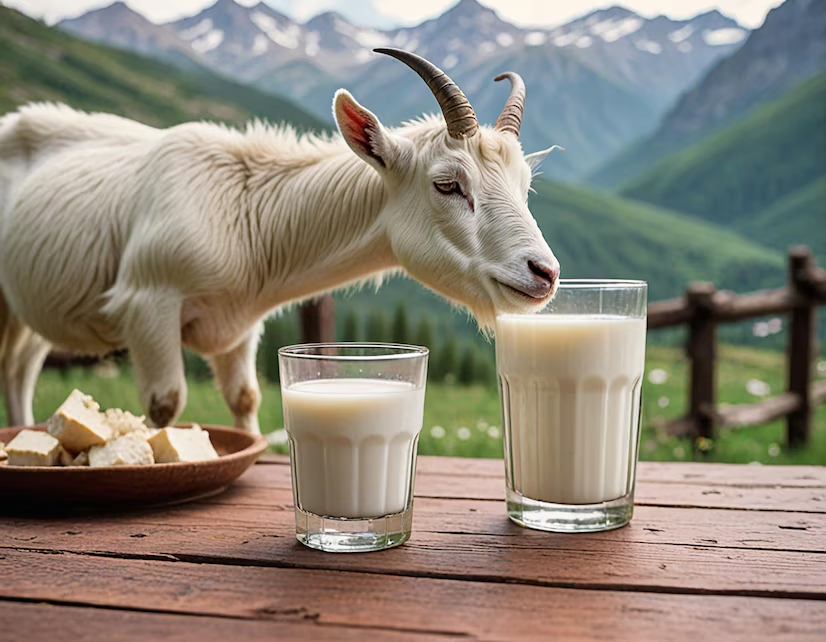Buffalo milk has been a staple in many cultures for centuries and is known for its rich, creamy texture and high nutritional value. While cow’s milk is more widely consumed globally, buffalo milk has its own set of benefits that make it an excellent alternative. In this article, we will explore the health benefits, nutritional content, and common uses of buffalo milk, highlighting why it could be a great addition to your diet.
What is Buffalo Milk?
Buffalo milk is the liquid secretion from buffaloes, predominantly water buffaloes, which are commonly found in regions like South Asia, parts of the Mediterranean, and the Middle East. Unlike cow’s milk, buffalo milk is thicker and has a creamier texture, thanks to its higher fat content. This makes it particularly popular for producing dairy products like butter, ghee, and cheese.
Nutritional Composition of Buffalo Milk
Buffalo milk is known for its rich nutritional profile. It contains several essential vitamins and minerals that contribute to its numerous health benefits. Below is a breakdown of its key components:
- High Fat Content: Buffalo milk has a fat content of around 7-8%, compared to cow’s milk which has about 3-4%. This makes it richer and creamier, perfect for dairy products.
- Protein: It is a great source of protein, providing all essential amino acids, which are crucial for muscle building and overall growth.
- Calcium: Buffalo milk is a significant source of calcium, supporting strong bones and teeth.
- Vitamins: It is rich in vitamins like vitamin A, vitamin D, and vitamin B12, essential for maintaining good vision, boosting immunity, and enhancing red blood cell production.
- Lactose: While buffalo milk does contain lactose, it has slightly less than cow’s milk, which might be easier to digest for some people with mild lactose sensitivity.
Health Benefits of Buffalo Milk
Buffalo milk offers numerous health benefits, making it a nutritious choice for various populations.
1.Rich Source of Energy
Due to its higher fat content, buffalo milk provides more energy per serving compared to cow’s milk. This can be beneficial for children, athletes, and those who need extra calories in their diet.
2.Supports Bone Health
The high calcium and vitamin D content in buffalo milk play a significant role in maintaining strong bones and teeth. Regular consumption can help prevent conditions like osteoporosis and improve overall bone density.
3.Improves Immunity
Buffalo milk contains more vitamin A and antioxidants than cow’s milk, which can enhance the immune system. These nutrients help fight off infections and promote healthy skin and vision.
4.Good for Heart Health
Although buffalo milk is rich in fat, the presence of omega-3 fatty acids can contribute to heart health. These healthy fats help reduce cholesterol levels and improve heart function when consumed in moderation.
5.Promotes Muscle Growth
Due to its high protein content, buffalo milk is an excellent source for muscle development. The essential amino acids present in the milk make it particularly useful for individuals looking to build or maintain muscle mass.
Buffalo Milk vs Cow Milk
While both types of milk are widely consumed, there are notable differences between buffalo and cow’s milk. Below are some of the main distinctions:
- Fat Content: Buffalo milk has almost double the fat content compared to cow’s milk, which gives it a creamier consistency.
- Protein: Buffalo milk contains more protein, making it a better option for those looking to increase their protein intake.
- Calcium: Buffalo milk has a higher calcium content, contributing more to bone health.
- Shelf Life: Due to its higher peroxidase activity, buffalo milk stays fresher for a longer period compared to cow’s milk.
- Lactose: While both contain lactose, buffalo milk has a slightly lower amount, which could make it easier to digest for those with mild lactose intolerance.
Uses of Buffalo Milk
Buffalo milk’s thick consistency and creamy texture make it ideal for various culinary uses. It is commonly used in:
1.Dairy Products
Buffalo milk is perfect for making rich dairy products like:
- Butter: Due to its high-fat content, buffalo milk produces butter that is creamier and more flavorful.
- Cheese: Famous cheeses like mozzarella are made from buffalo milk, offering a rich and distinct taste.
- Ghee: In South Asia, buffalo milk is used to make ghee, a clarified butter essential in many traditional dishes.
2.Desserts
Buffalo milk is often used in traditional sweets and desserts due to its rich taste. Popular desserts like kulfi (Indian ice cream) and rice puddings are made with buffalo milk for a creamier texture.
3.Milk-Based Beverages
Buffalo milk can be consumed as-is or used in beverages like milkshakes and smoothies. Its rich texture adds thickness and enhances the flavor of these drinks.
Buffalo Milk and Lactose Intolerance
While buffalo milk does contain lactose, some people with mild lactose intolerance may find it easier to digest than cow’s milk. This is because buffalo milk contains less lactose and has a thicker texture, which can make it more tolerable for those with slight sensitivities.
However, people with severe lactose intolerance should still avoid buffalo milk or opt for lactose-free alternatives to prevent digestive issues.
Who Should Avoid Buffalo Milk?

While buffalo milk is rich in nutrients, it may not be suitable for everyone. Those with the following conditions should consult a healthcare provider before consuming it:
- High Cholesterol: Due to its higher fat content, individuals with high cholesterol levels should consume buffalo milk in moderation.
- Lactose Intolerance: People with severe lactose intolerance may experience digestive discomfort after consuming buffalo milk.
Conclusion
Buffalo milk is a nutrient-dense alternative to cow’s milk, offering a rich source of energy, protein, and essential vitamins and minerals. Its creamy texture makes it ideal for various culinary uses, from butter and cheese to desserts and beverages. While it may not be as popular as cow’s milk globally, its health benefits and versatility make it a valuable addition to any diet.
Whether you’re looking for a richer alternative to cow’s milk or a new way to enhance your dairy products, buffalo milk is worth considering. With its ability to support bone health, improve immunity, and promote muscle growth, it stands out as a powerful source of nutrition.
FAQs
Is buffalo milk healthier than cow’s milk?
Buffalo milk has a higher fat, protein, and calcium content, making it more nutritious in some aspects. However, it also contains more calories and should be consumed in moderation.
Can people with lactose intolerance drink buffalo milk?
While buffalo milk has slightly less lactose than cow’s milk, it may still cause discomfort for those with lactose intolerance. It’s best to consult a doctor if you have severe lactose sensitivity.
How does buffalo milk taste compared to cow’s milk?
Buffalo milk has a creamier and richer taste due to its higher fat content, making it ideal for dairy products like butter, cheese, and ghee.
Is buffalo milk good for children?
Yes, buffalo milk can be beneficial for children due to its high calcium and protein content, which supports growth and bone development.
Where can I buy buffalo milk?
Buffalo milk is commonly available in regions where water buffaloes are raised, such as South Asia and parts of the Mediterranean. It may also be found in specialty stores in other regions.









